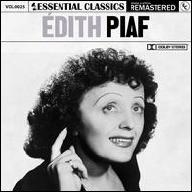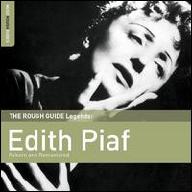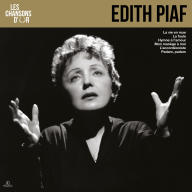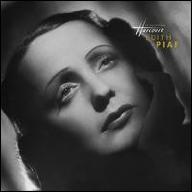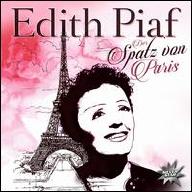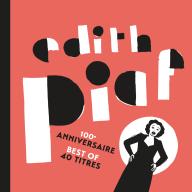Piaf was born Édith Giovanna Gassion on December 19, 1915, in Ménilmontant, one of the poorer districts of Paris. According to legend, she was born under a street light on the corner of the Rue de Belleville, with her mother attended by two policemen; some have disputed this story, finding it much likelier that she was born in the local hospital. Whatever the case, Piaf's origins were undeniably humble. Her father, Louis Gassion, was a traveling acrobat and street performer, while her Moroccan-Italian mother, Anita Maillard, was an alcoholic, an occasional prostitute, and an aspiring singer who performed in cafés and on street corners under the name Line Marsa. With her father serving in World War I, Édith was virtually ignored by both her mother and grandmother; after the war, her father sent her to live with his own mother, who helped run a small brothel in the Normandy town of Bernay. The prostitutes helped look after Édith when they could; one story goes that when five-year-old Édith lost her sight during an acute case of conjunctivitis, the prostitutes shut down the brothel to spend a day praying for her in church, and her blindness disappeared several days later.
Édith's father returned for her in 1922, and instead of sending her to school, he brought her to Paris to join his street act. It was here that she got her first experience singing in public, but her main duty at first was to pass the hat among the crowd of onlookers, manipulating extra money from whomever she could. She and her father traveled all over France together until 1930, when the now-teenaged Édith had developed her singing into a main attraction. She teamed up with her half-sister and lifelong partner in mischief, Simone Berteaut, and sang for tips in the streets, squares, cafés, and military camps, while living in a succession of cheap, squalid hotels. In 1932, she fell in love with a delivery boy named Louis Dupont, and bore him a daughter. Much like her own mother, Édith found it difficult to care for a child while working in the streets, and often left her daughter alone. Dupont eventually took the child himself, but she died of meningitis several months later.
Living the high-risk life that she did, Édith Gassion almost certainly would have come to a bad end had she not been discovered by cabaret owner Louis Leplée while singing on a street corner in the Pigalle area in 1935. Struck by the force of her voice, Leplée took the young singer under his wing and groomed her to become his resident star act. He renamed her "La Môme Piaf" (which in Parisian slang translates roughly as "the little sparrow" or "the kid sparrow"), fleshed out her song repertoire, taught her the basics of stage presence, and outfitted her in a plain black dress that would become her visual trademark. Leplée's extensive publicity campaign brought many noted celebrities to Piaf's opening night, including Maurice Chevalier; she was a smashing success, and in January 1936, she cut her first records for Polydor, "Les Mômes de la Cloche" and "L'Étranger"; the latter was penned by Marguerite Monnot, who would continue to write for Piaf for the remainder of both their careers.
Tragedy struck in April 1936, when Leplée was shot to death in his apartment. Police suspicion initially fell on Piaf, and the ensuing media furor threatened to derail her career even after she was cleared of any involvement. Scandal preceded her when she toured the provinces outside Paris that summer, and she realized that she needed help in rehabilitating her career and image. When she returned to Paris, she sought out Raymond Asso, a songwriter, businessman, and Foreign Legion veteran; she had rejected his song "Mon Légionnaire," but it had subsequently been recorded by Marie Dubas, one of Piaf's major influences. Intensely attracted to Piaf, Asso began an affair with her and took charge of managing her career. He partially restored her real name, billing her as Édith Piaf; he barred all of Piaf's undesirable acquaintances from seeing her; he set about making up for the basic education that neither Édith nor Simone had received. Most importantly, he talked with Piaf about her childhood on the streets, and teamed up with "L'Étranger" composer Marguerite Monnot to craft an original repertoire that would be unique to Piaf's experiences. In January 1937, Piaf recorded "Mon Légionnaire" for a major hit, and went on to cut the Asso/Monnot collaborations "Le Fanion de la Légion," "C'est Lui Que Mon Coeur a Choisi" (a smash hit in late 1938), "Le Petit Monsieur Triste," "Elle Frequentait la Rue Pigalle," "Je N'en Connais Pas la Fin," and others. Later that year, Piaf made concert appearances at The ABC Theater (where she opened for Charles Trenet) and The Bobino (as the headliner); the shows were wildly successful and made her the new star of the Paris music scene.
In the fall of 1939, Asso was called to serve in World War II. Early the next year, Piaf recorded one of her signature songs, "L'Accordéoniste," just before its composer, Michel Emer, left for the war; she would later help the Jewish Emer escape France during the Nazi occupation. In Asso's absence, she took up with actor/singer Paul Meurisse, from whom she picked up the refinements and culture of upper-class French society. They performed together often, and also co-starred in Jean Cocteau's one-act play Le Bel Indifférent; however, their relationship soon deteriorated, and Piaf and Simone moved into an apartment over a high-class brothel. By this time, the Nazis had taken over Paris, and the brothel's clientele often included Gestapo officers. Piaf was long suspected of collaborating with -- or, at least, being overly friendly to -- the Germans, making numerous acquaintances through her residence and performing at private events. She resisted in her own way, however; she dated Jewish pianist Norbert Glanzberg, and also co-wrote the subtle protest song "Où Sont-Ils Mes Petits Copains?" with Marguerite Monnot in 1943, defying a Nazi request to remove the song from her concert repertoire. According to one story, Piaf posed for a photo at a prison camp; the images of the French prisoners in the photo were later blown up and used in false documents that helped many of them escape.
Before the war's end, Piaf took up with journalist Henri Contet, and convinced him to team up with Marguerite Monnot as a lyricist. This proved to be the most productive partnership since the Asso years, and Piaf was rewarded with a burst of new material: "Coup de Grisou," "Monsieur Saint-Pierre," "Le Brun et le Blond," "Histoire du Coeur," "Y'a Pas D'Printemps," and many others. Her affair with Contet was relatively brief, but he continued to write for her after they split; meanwhile, Piaf moved on to an attractive young singer named Yves Montand in 1944. Under Piaf's rigorous tutelage, Montand grew into one of French pop's biggest stars within a year, and she broke off the affair when his popularity began to rival her own. Her next protégés were a nine-member singing group called Les Compagnons de la Chanson, who toured and recorded with her over the next few years (one member also became her lover). Now recording for the Pathe label, she scored a major hit in 1946 with "Les Trois Cloches," which would later become an English-language smash for the Browns when translated into "The Three Bells." Later that year, she recorded the self-composed number "La Vie en Rose," another huge hit that international audiences would come to regard as her signature song.
Piaf embarked on her first American tour in late 1947, and at first met with little success; audiences expecting a bright, gaudy Parisian spectacle were disappointed with her simple presentation and downcast songs. Just as she was about to leave the country, a prominent New York critic wrote a glowing review of her show, urging audiences not to dismiss her out of hand; she was booked at The Café Versailles in New York, and thanks to the publicity, she was a hit, staying for over five months. In that time, she met up with French boxer Marcel Cerdan, an acquaintance of about a year. In spite of Cerdan's marriage, the two began a passionate affair, not long before Cerdan won the world middleweight championship and became a French national hero. Unfortunately, tragedy struck in October 1949, when Cerdan was planning to visit Piaf in New York; wanting him to arrive sooner, she convinced him to take a plane instead of a boat. The plane crashed in the Azores, killing him. Devastated by guilt and grief, Piaf sank into drug and alcohol abuse, and began to experiment with morphine. In early 1950, she recorded "L'Hymne à l'Amour," a tribute to the one lover Piaf would never quite get over; co-written with Marguerite Monnot, it became one of her best-known and most heartfelt songs.
In 1951, Piaf met the young singer/songwriter Charles Aznavour, a future giant of French song who became her next protégé; unlike her others, this relationship always remained strictly platonic, despite the enduring closeness and loyalty of their friendship. Aznavour served as a jack-of-all-trades for Piaf -- secretary, chauffeur, etc. -- and she helped him get bookings, brought him on tour, and recorded several of his early songs, including the hit "Plus Bleu Que Tes Yeux" and "Jézébel." Their friendship nearly came to an early end when both were involved in a serious car accident (as passengers); Piaf suffered a broken arm and two broken ribs. With her doctor prescribing morphine for pain relief, she soon developed a serious chemical dependency to go with her increasing alcohol problems. In 1952, she romanced and married singer Jacques Pills, who co-wrote her hit "Je T'ai Dans la Peau" with his pianist, Gilbert Bécaud; Bécaud would soon go on to become yet another of the pop stars launched into orbit with Piaf's assistance. Meanwhile, Pills soon discovered the gravity of her substance abuse problems, and forced her into a detox clinic on three separate occasions. Nonetheless, Piaf continued to record and perform with great success, including appearances at Carnegie Hall and Paris' legendary Olympia theater. She and Pills divorced in 1955; not long afterward, she suffered an attack of delirium tremens and had to be hospitalized.
As an interpretive singer, Piaf was at the height of her powers during the mid-'50s, even in spite of all her health woes. Her international tours were consistently successful, and the devotion of her massive French following verged on worship. She scored several more hits over 1956-1958, among them "La Foule," "Les Amants D'un Jour," "L'homme à la Moto," and the smash "Mon Manège à Moi." During that period, she also completed another stay in detox; this time would prove to be successful, but years of drug and alcohol abuse had already destabilized her health. In late 1958, she met another up-and-coming songwriter, Georges Moustaki, and made him her latest lover and improvement project. Teaming once again with Marguerite Monnot, Moustaki co-wrote "Milord," an enormous hit that topped the charts all over Europe in early 1959 and became Piaf's first successful single in the U.K. Later that year, she and Moustaki were involved in another car accident, in which her face was badly cut; in early 1960, while performing at the Waldorf Astoria in New York, she collapsed and began to vomit blood on-stage, and was rushed to the hospital for emergency stomach surgery. Stubbornly, she continued her tour, and collapsed on-stage again in Stockholm; this time she was sent back to Paris for more surgery.
Piaf was soon back in the recording studio, eager to record a composition by the legendary French songwriter Charles Dumont. "Non, Je Ne Regrette Rien" became one of her all-time classics and a huge international hit in 1960, serving as something of an equivalent to Frank Sinatra's "My Way." Piaf went on to score further hits with more Dumont songs, including "Mon Dieu," "Les Flons-Flons du Bal," and "Les Mots D'Amour." She staged a lengthy run at The Olympia in 1961, and later that year met an aspiring Greek singer named Théo Sarapo (born Theophanis Lamboukis), who became her latest project and, eventually, second husband. Sarapo was half her age, and given Piaf's poor health, the French media derided him as a gold digger. Nonetheless, they cut the duet "À Quoi Ça Sert l'Amour" in 1962, and performed together during Piaf's final engagement at The Olympia that year. Despite her physical weakness -- on some nights, she could barely stand -- she had lost very little of the power in her voice.
Piaf and Sarapo sang together at The Bobino in early 1963, and she also made her final recording, "L'Homme de Berlin." Not long afterward, Piaf slipped into a coma, brought on by cancer. Sarapo and Simone Berteaut took Piaf to her villa in Plascassier, on the French Riviera, to nurse her. She drifted in and out of consciousness for months before passing away on October 11, 1963 -- the same day as legendary writer/filmmaker Jean Cocteau. Her body was taken back to Paris in secret, so that fans could believe she died in her hometown. The news of her death caused a nationwide outpouring of grief, and tens of thousands of fans jammed the streets of Paris, stopping traffic to watch her funeral procession. Her towering stature in French popular music has hardly diminished in the years since; her grave at Père-Lachaise remains one of the famed cemetery's most visited, and her songs continue to be covered by countless classic-style pop artists, both French and otherwise. ~ Steve Huey, Rovi


